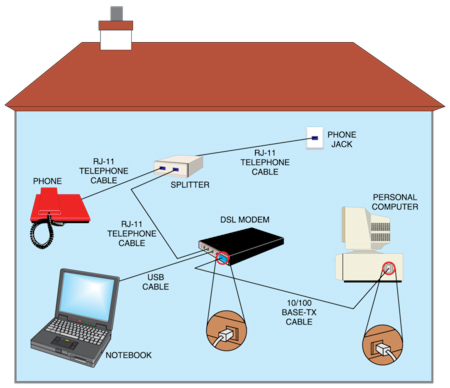The pair from the DSLAM is terminated into the main distribution frame (MDF), from where connections are provided to subscribers via twisted copper pair lines. These twisted pair lines terminate at DP box placed near a subscriber’s home/workplace. The connection from DP box is first run to the splitter that sits in the customer’s premises. The splitter, which is basically a low-pass filter,removes the plain old telephone system (POTS) signal (voice signal, 300-3400 Hz) from the incoming DSL signal. The high-frequency filtered DSL signal is then given to a DSL modem. Now the connection is taken out from Ethernet port of DSL modem and terminated to the subscriber’s computer (Fig. 2).
The underlying technology of transport across DSL facilities is a high-frequency sinusoidal carrier modulation, which is an analogue-based signal transmission. Each end of a DSL circuit has a modem that modulates patterns of bits into certain high-frequency tones, representing that bit pattern, for transmission across the length of the facility. Tones received from the far-end modem are demodulated back into a corresponding bit pattern that the near-end modem retransmits, in true digital form as pulses of voltage, to its interfaced equipment (such as a computer, router and switch).
Unlike traditional dial-up modems, which modulate bits into carrier that can fall only in the 300-3400Hz base-band (voice service), DSL modems modulate frequencies from 4 kHz to as high as 4 MHz. This frequency band separation enables DSL service and POTS to coexist on the same copper pair facility.
DSL technology divides the frequencies used in a single phone-line into two primary bands. The high-frequency band is used for data services and lower-frequency band (below 4 kHz) is utilised for voice. Ideally, DSL service provides ‘always-on’ connection to the customers to access the Internet. DSL service implemented with point-to-point over Ethernet (PPoE) does not support ‘always-on’ connection, but even in this case a DSL router/modem can automate the connection process.

Different xDSL technologies
The DSL technology is based on discrete multi-tone modulation technique and covers a number of similar yet competing forms of DSL (collectively termed as xDSL) including IDSL, HDSL, SHDSL, ADSL, RADSL, UDSL, Etherloop, VDSL and GDSL. xDSL is drawing significant attention from implementers and service providers because it promises to deliver high-bandwidth data rates to dispersed locations with relatively small changes to the existing telco infrastructure.
These technologies are differentiated by:
1. Speed of transmission
2. Maximum distance of signal transmission
3. Variation in speed between upstream and downstream
4. Symmetric or asymmetric character of the connection
Currently, the primary focus in xDSL is on the development and deployment of ADSL and VDSL technologies and architectures.
ISDN digital subscriber line (IDSL). This is an integrated services digital network (ISDN)-based technology that provides data flowrates of 144 kbps, which is slightly higher than the dual-channel ISDN data rate of 128 kbps. The goodness of IDSL lies in its ‘always-on’ connectivity which transmits data via a data network rather than the carrier’s voice network. Thus it gives freedom from overloading of voice switches by data users.
IDSL uses a 2B1Q (two-binary, one-quaternary) line code on a single copper pair line to transmit information through the ISDN ‘U’ interface. The major limitation of IDSL is that customers cannot access ISDN signaling or voice services. But if the requirement is Internet browsing at higher speed, IDSL is a better option than ISDN.
High-bit rate digital subscriber line (HDSL). HDSL is a symmetric technology that provides the same amount of bandwidth for upstream and downstream traffic. It offers spee of 2.048 Mbps over two copper pairs with operating distances of 3.6 km to 4.6 km, and is ideal for connecting PBX systems, digital local loops, point of presence, Internet servers and campus-based networks.
HDSL-II. HDSL-II, another technology proposed within the American National Standard Institute (ANSI) and the European Telecommunication Standard Institute (ETSI), offers the performance of HDSL but over a single pair.
HDSL was originally developed in USA, as a better technology for high-speed local exchange carrier systems which carry high-speed data links and voice channels using T1 lines. T-carrier circuits operate at 1.544Mbps and were carried using alternate mark inversion (AMI) line code. Due to limited range of AMI, the line code B8ZS (bipolar 8-zero substitution) has been used. Later, 2B1Q line code was used, which allowed a 784kbps data rate over a single twisted-pair cable and 1.544Mbps with two twisted-pair cables. But, the problem still continued due to the differences between the T1 (1.544Mbps) and E1 (2.048 Mbps) standards.






